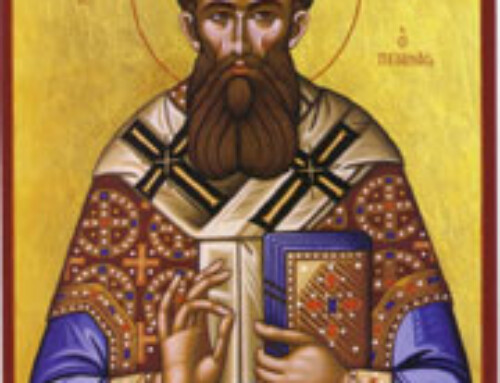Word Magazine November 1958 Page 6
ONE FORM FOR LAYMEN?
By Fr. Michael Buben, Geneva, N. Y.
Roman bishops and priests partake of the Body and Blood of Christ in the same manner as do all Orthodox Christians; however, Roman laymen partake of Communion only in the form of the Body of Christ. This Roman custom appeared during the middle-ages simply because some felt, that giving the laymen Communion in two forms on a spoon might help to spread disease.
Following are a few Biblical texts which will remind us how Our Savior instituted the Mystery of Holy Communion: We read in the Gospel of Saint Matthew 26, 26. “And as they were eating, Jesus took Bread, and blessed it, and brake it, and gave it to the Disciples, and said, Take eat; this is My Body.” “And He took the Cup, and gave thanks, and gave it to them saying, Drink ye all of it; for this is My Blood of the New Testament, which is shed for many for the remission of sins.”
Evangelists Mark and Luke also write in this essence with St. Luke adding Christ’s words – “Do this in remembrance of Me!” The Apostle Paul in his first Epistle to the Corinthians (11, 26) writes “For as often as you eat this Bread, and drink this Cup, ye do shew the Lord’s death till He come.” St. John writes in his sixth chapter —”Then Jesus said unto them, Verily, verily, I say unto you, Except ye eat the Flesh of the Son of man, and drink His Blood, ye have no life in you. Whoso eateth My Flesh, and drinketh My Blood, hath eternal life; and I will raise him up at the last day.”
Let us compare this teaching of our Saviour’s with the Roman teaching. The Roman’s say —”Where the Body is, there also is Blood.”
Take the word SHED as used in the sentence — “Which is SHED for you and for many for the remission of sins. Does this word not convey the fact that during our Lord’s suffering and death on the Holy Cross, the Blood was separated from the Body? Indeed it does. Also His command was— “Take eat etc.” AND “Drink ye etc.” “For as often as you eat this bread, AND drink this cup, ye do shew the Lord’s death till He come.’’ teaches Apostle Paul.
How is it possible to follow this teaching and yet partake only of the Body? (Wafer form). Christ said, after taking the Wine, separately from the Bread: “Drink ye etc. then He severely tells about those who fail to fulfill this command: “Except ye eat the Flesh of the Son of man, and drink His Blood ye have no life in you.”
To justify themselves, the Roman’s point out that in the early Church for those who were unable to be present at Mass because of illness, the priests brought the Sacrament in the form of Christ’s Body only. True, for the sick and feeble the Sacrament is reserved, but the particle (BODY) used for this purpose is thoroughly soaked in the BLOOD, during the Liturgy where both forms were consecrated (Epiclesis). The Orthodox Church to this day reserves the Sacrament in this way to be carried to those who are ill, strictly following the practice of the early Church.
Would it not have been easier to use many spoons for a group of especially ill communicants, than to change that which has been installed by Christ Himself? Orthodox Christians have faith that Communion restores not only spiritual but physical strength, and that those who partake with “the fear of God, with love and Faith” add each time, the fuel for eternal life.
The rise of a spoon has its foundation in the Old Testament. That is another story, however, not now pertinent.

